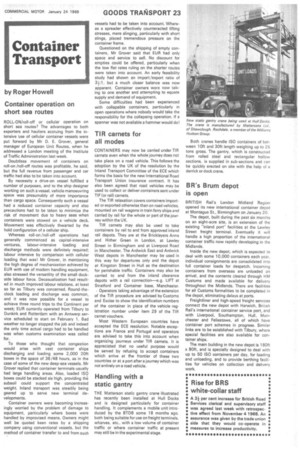Container Transport
Page 25

If you've noticed an error in this article please click here to report it so we can fix it.
by Roger Howell Container operation on short sea routes
ROLL-ON/roll-off or cellular operation on short sea routes? The advantages to both exporters and hauliers accruing from the intensive use of cellular container vessels were put forward by Mr D. E. Grover, general manager of European Unit Routes, when he addressed a London meeting of the Institute of Traffic Administration last week.
Doubtless movement of containers on roll-on /roll-off routes was profitable, he said, but the full revenue from passenger and car traffic had also to be taken into account.
By necessity a drive-on vessel fulfilled a number of purposes, and to the ship designer working on such a vessel, vehicle manoeuvring space was presumably of more importance than cargo space. Consequently such a vessel had a reduced container capacity and also precautions had to be taken to minimize the risk of movement due to heavy seas when containers were stowed on a vehicle deck. Movement was effectively thwarted by the hold configuration of a cellular ship.
Whereas roll-on /roll-off operations had generally commenced as capital-intensive ventures, labour-intensive loading and discharge methods were definitely required; labour intensive by comparison with cellular loading that was! Mr Grover, in mentioning the high degree of mechanization achieved by EUR with use of modern handling equipment, also stressed the versatility of the small dockside labour force, Decasualization had resulted in much improved labour relations, at least so far as Tilbury was concerned. Round-theclock loading and discharge was common, and it was now possible for a vessel to achieve three round trips to the Continent per week; EUR currently operated from Tilbury to Dunkirk and Rotterdam with an Antwerp service scheduled to start on February 1. Bad weather no longer stopped the job and indeed the only time actual cargo had to be handled was when customs examination was called for. • To those who thought that congestion would arise with vast container ships discharging and loading some 2,000 20ft boxes in the space of 36/48 hours, as in the case of some of the new deep-sea vessels, Mr Grover replied that container terminals usually had large handling areas. Also, loaded ISO boxes could be stacked six high, providing the subsoil could support the concentrated weight. Inland transport was steadily being geared up to serve new terminal developments.
Container owners were becoming increasingly worried by the problem of damage to equipment, particularly where boxes were handled by improvised means. Owners might well be quoted keen rates by a shipping company using conventional vessels, but the method of container transfer to and from such vessels had to be taken into account. Whereas a spreader effectively counteracted lifting stresses, mere slinging, particularly with short slings, placed tremendous pressure on the container frame.
Questioned on the shipping of empty containers, Mr Grover said that EUR had only space and service to sell. No discount for empties could be offered, particularly when the low flat rates ruling on the shorter routes were taken into account. An early feasibility study had shown an import/export ratio of 31:1, but a much closer balance was now apparent. Container owners were now talking to one another and attempting to equate supply and demand of equipment.
Some difficulties had been experienced with collapsible containers, particularly in open operations where nobody would take the responsibility for the collapsing operation. If a spanner was not available a hammer would do!








































































































